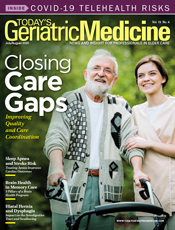
July/August 2020
Education: Reopening the Book on Geriatric Education “Responsibility for learning belongs to the student, regardless of age.” — Robert Martin On March 13, 2018, the US Census Bureau published a correction to previously projected infant mortality rates, indicating errors that skewed the estimated overall number of deaths. When these errors were detected and calculations were appropriately revised, it became clearer that older adults are projected to outnumber children for the first time in US history. Moreover, baby boomers will all be older than 65 by 2030, at which point 1 in 5 US residents will be at retirement age.1 Challenges for Geriatrics Education You may have had a positive preclinical experience or clinical exposure to working with older adult populations. Perhaps your mentor was a geriatrician, primary care provider, or a clinician in another specialty or discipline with an interest in providing high-quality medical care to older adults. Despite your good work and passion, while “the demand for doctors specialized in the medical care of elderly patients is increasing, the interest among medical students for a career in geriatrics is lagging behind.”2 According to the American Geriatrics Society, as many as 30% of older adults need care from a geriatrician. The society further notes that even if each currently practicing geriatrician cared for 700 patients, there would still be an estimated 45% increase in need for geriatricians between 2013 and 2025. Even more concerning is that this 45% increase in demand for geriatricians is expected to occur five years before all baby boomers will hit age 65 in 2030.3 Helping Students Discover a Passion for Geriatrics Meiboom and colleagues also developed a concept map that identified a lack of geriatricians entering and maintaining practice and what could be done to remedy this problem. This concept map includes the following categories of focus that can influence medical students to choose geriatrics as a profession4: • “a patient-centered medical curriculum”; Given these five approaches, how can the cause of geriatric education be promoted to create more interest among students in health care education and for those already in practice? Educators might do well to modify health care educational curricula to focus on a truly patient-centered approach attentive to the needs of older adult patients and their family members.3 In light of a rapidly aging society, a representative sample of educational material must include greater amounts of geriatric content.4 Inside the walls of the academy and the medical practice environment alike, educators and geriatric clinicians should collaborate on developing effective methods that make geriatrics intellectually stimulating while simultaneously fostering a humane and “emotionally appealing” environment. When mentoring students and new practitioners, experienced geriatric educators and clinicians can point students to positive geriatric career perspectives and financial potential within the field of geriatric medicine and help them identify the type of health care providers they want to be. This is critical to increasing the number of geriatric clinicians needed to meet increasing societal aging needs.4 These activities might be integrated into in-class activities, clinical supervision time, structured interprofessional simulations, and continued education offerings, for example. Examples of grant opportunities that could support curricular development from the Health Resources & Services Administration include the Geriatric Academic Career Award and the Geriatrics Workforce Enhancement Program.5 Final Thoughts — David Hage, MSW, LCSW, ACSW, C-ASWCM, is an assistant professor of social work and gerontology at Misericordia University in Dallas, Pennsylvania. He is also the cofounder and a practicing Aging Life Care Professional and consultant at Pathway Senior Care Associates, LLC.
Geriatrics Educational Resources for Educators • Academy for Gerontology Education in Higher Education: offers education, training, curricular innovations, and research programs in the field of aging. • Consult Geri: a clinical education resource including courses, podcasts, webinars, tools, and other resources focused on the care of older adults provided by the Hartford Institute for Geriatric Nursing. • American Federation of Aging Research: a research organization focused on aging issues that also lists established Geriatric Centers for Excellence. • National Association of Geriatric Education: an educational organization dedicated to improving the education/training, supply, distribution, diversity, and quality of health care professionals, ultimately to improve the quality of health care for all elderly individuals, including underserved and minority groups.
Geriatrics Educational Resources for Health Care Providers • American Academy of Family Physicians Geriatric Toolbox: clinical resources for family physicians working with older adults. • American Geriatrics Society Geriatrics Review Syllabus: A Core Curriculum in Geriatric Medicine, 10th Edition: a comprehensive reference containing the latest developments in the field of geriatric medicine. • Consult Geri: a clinical education resource including courses, podcasts, webinars, tools, and other resources focused on the care of older adults provided by the Hartford Institute for Geriatric Nursing.
References 2. Meiboom AA, de Vries H, Hertogh CM, Scheele F. Why medical students do not choose a career in geriatrics: a systematic review. BMC Med Edu. 2015;15:101. 3. Geriatrics workforce by the numbers. American Geriatrics Society website. https://www.americangeriatrics.org/geriatrics-profession/about-geriatrics/geriatrics-workforce-numbers. Accessed April 10, 2020. 4. Meiboom AA, Vries HD, Scheele F, Hertogh CMPM. Raising enthusiasm for the medical care of elderly patients: a concept mapping study to find elements for an elderly friendly medical curriculum. BMC Med Edu. 2018;18(1):283. 5. Grants. Health Resources & Services Administration website. https://www.hrsa.gov/grants/index.html. Published November 27, 2017. Accessed April 10, 2020. 6. Piedra L, Howe M, Ridings J, et al. Re-conceptualizing positive aging: researcher and practitioner perspectives. Innov Aging. 2018;2(Suppl 1):397-398. 7. Hahn RA, Truman BI. Education improves public health and promotes health equity. Int J Health Serv. 2015;45(4):657-678. |
